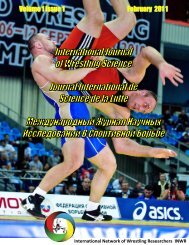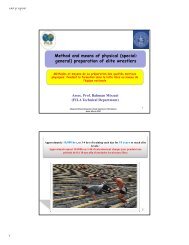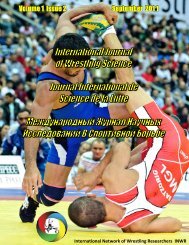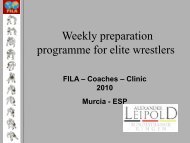Physiological profile of the young Egyptian wrestlers - INWR Wrestling
Physiological profile of the young Egyptian wrestlers - INWR Wrestling
Physiological profile of the young Egyptian wrestlers - INWR Wrestling
Create successful ePaper yourself
Turn your PDF publications into a flip-book with our unique Google optimized e-Paper software.
World Journal <strong>of</strong> Sport Sciences 6 (1): 45-50, 2012<br />
ISSN 2078-4724<br />
© IDOSI Publications, 2012<br />
DOI: 10.5829/idosi.wjss.2012.6.1.1110<br />
<strong>Physiological</strong> Pr<strong>of</strong>ile <strong>of</strong> <strong>the</strong> Young <strong>Egyptian</strong> Wrestlers<br />
Ahmed H. Saad<br />
Department <strong>of</strong> Theories and Applications <strong>of</strong> Combat Sports,<br />
Faculty <strong>of</strong> Physical Education, Benha University, Egypt<br />
Abstract: The study aims to identify <strong>the</strong> physiological <strong>pr<strong>of</strong>ile</strong> characteristics <strong>of</strong> <strong>the</strong> <strong>Egyptian</strong> youth <strong>wrestlers</strong><br />
as well as to identify <strong>the</strong> differences in <strong>the</strong> physiological <strong>pr<strong>of</strong>ile</strong> between small weights <strong>wrestlers</strong> and medium<br />
weights <strong>wrestlers</strong> in <strong>the</strong> physiological measurements under investigation, at rest and after <strong>the</strong> effort. The<br />
research sample was purposefully chosen from <strong>the</strong> winning <strong>wrestlers</strong> ranking between first to sixth position in<br />
<strong>the</strong> National Championship. Sample included 30 <strong>wrestlers</strong> aged 16:18 years, divided into two groups: 12 small<br />
weights <strong>wrestlers</strong> <strong>the</strong>ir weight between 50: 60 kg and 18 medium weights <strong>wrestlers</strong> <strong>the</strong>ir weight between 66: 84<br />
kg. The most important results are <strong>the</strong> existence <strong>of</strong> set <strong>of</strong> distinctive physiological characteristics <strong>of</strong> <strong>the</strong><br />
<strong>Egyptian</strong> <strong>wrestlers</strong> within <strong>the</strong> sample under investigation, in addition to <strong>the</strong> existence <strong>of</strong> differences, but not<br />
statistically significant between small weights <strong>wrestlers</strong> and medium weights <strong>wrestlers</strong> in <strong>the</strong> physiological<br />
variables under study.<br />
Key words: <strong>Physiological</strong> <strong>pr<strong>of</strong>ile</strong> % Wrestlers<br />
INTRODUCTION<br />
A number <strong>of</strong> studies investigate physiological factors<br />
in combat sport.One study investigated aerobic capacity<br />
<strong>Wrestling</strong> is a sport consisting <strong>of</strong> high intensity body composition <strong>of</strong> sumo <strong>wrestlers</strong> to athletes in combat<br />
efforts interspersed with brief periods <strong>of</strong> mild- to and o<strong>the</strong>r sports [6]. Ano<strong>the</strong>r investigated <strong>the</strong> variation in<br />
moderate-intensity work or resting characterized by <strong>the</strong> resistive force selection during brief high intensity cycle<br />
evort <strong>of</strong> <strong>the</strong> athlete to maintain physical control over his ergometry and discussed <strong>the</strong> implications <strong>of</strong> <strong>the</strong>se results<br />
opponent. Recent rule changes have shortened match for power assessment and production in elite karate<br />
duration (from 5 to 2-min rounds) and encouraged power practitioners [7]. A third investigated heart rate and blood<br />
maneuvers that require both absolute whole-body lactate responses to modern wushu techniques [8]. A<br />
strength and explosiveness integrating a large isometric group <strong>of</strong> researchers conducted a three dimensional<br />
component for technical performance [1]. A wrestling analysis <strong>of</strong> <strong>the</strong> center <strong>of</strong> mass for three different judomatch<br />
requires tremendous physical activity, power and throwing techniques [9].<br />
strength <strong>of</strong> body musculature as well as isometric force <strong>Wrestling</strong> is one <strong>of</strong> <strong>the</strong> combat sports that require<br />
for various wrestling techniques [2].<br />
great effort and a high degree <strong>of</strong> compatibility between<br />
Power in <strong>wrestlers</strong> is related with quick and explosive <strong>the</strong> exerted physical effort and <strong>the</strong> efficiency <strong>of</strong> <strong>the</strong><br />
effort that leads to wrestling success [3]. Anaerobic internal organs in <strong>the</strong> body in order to <strong>the</strong> wrestler is able<br />
power and capacity are important in wrestling because <strong>of</strong> to achieve <strong>the</strong> physiological requirements <strong>of</strong> performance.<br />
<strong>the</strong> need <strong>of</strong> short-duration and high intensity A wrestling match is an intermittent physical exercise<br />
performance. Wingate test can be used to reflect <strong>the</strong> <strong>of</strong> variable intensity [10]. It is characterized by sudden,<br />
maximum ability <strong>of</strong> <strong>wrestlers</strong> to generate power [4]. explosive attacks and counterattacks that are executed<br />
Demand on <strong>the</strong> cardiovascular system. Oxygen demand repeatedly [11] In wrestling, as in many o<strong>the</strong>r sports, both<br />
by <strong>the</strong> muscles increases sharply. Metabolic processes anaerobic and aerobic energy systems are employed to a<br />
speed up and more waste is created. More nutrients are various degree [12, 13]. The anaerobic system provides<br />
used and body temperature rises. To perform as efficiently <strong>the</strong> short, quick bursts <strong>of</strong> maximal power during <strong>the</strong> match<br />
as possible <strong>the</strong> cardiovascular system must regulate <strong>the</strong>se while <strong>the</strong> aerobic system contributes to <strong>the</strong> wrestler’s<br />
changes and meet <strong>the</strong> body's increasing demands [5]. ability to sustain effort for <strong>the</strong> duration <strong>of</strong> <strong>the</strong> match [13].<br />
Corresponding Author: Ahmed H. Saad, Department <strong>of</strong> Theories and Applications <strong>of</strong> Combat Sports,<br />
Faculty <strong>of</strong> Physical Education, Benha University, Egypt.<br />
45
World J. Sport Sci., 6 (1): 45-50, 2012<br />
As regards <strong>the</strong> duration <strong>of</strong> <strong>the</strong> load, this factor has measurements used a cycle ergo meter (150 W, b/min).<br />
significant physiological implications. When making an Fox test was taken after <strong>the</strong> first minute and <strong>the</strong> end <strong>of</strong> <strong>the</strong><br />
effort involving over 1/6 or 1/7 <strong>of</strong> total body musculature fifth minute, The study used <strong>the</strong> following equations to<br />
(e.g. running), <strong>the</strong> cardiovascular, respiratory, measure <strong>the</strong> variables under consideration:<br />
neuromuscular and metabolic systems actively participate<br />
in <strong>the</strong> exercise. If <strong>the</strong> duration <strong>of</strong> exercise is equal to or C Heart rate (HR)(resting - effort)<br />
less than 1 minute, <strong>the</strong> cardiovascular system will be<br />
important throughout <strong>the</strong> repetitions (and during <strong>the</strong> The heart rate was measured by a specialist using a<br />
pauses) but <strong>the</strong>re will not be enough time - in each stethoscope.<br />
repetition, mainly <strong>the</strong> first - for <strong>the</strong> neuromuscular system<br />
to take part. We could say that <strong>the</strong>re is “a physiological C Blood pressure, systolic (SP) and diastolic (DP)(<br />
delay” in <strong>the</strong> response and adjustment between <strong>the</strong> resting - effort)<br />
cardiovascular and neuromuscular systems that is used<br />
by intermittent exercise [14].<br />
Blood pressure measurements were taken both supine<br />
So <strong>the</strong> Cardiovascular respiratory system is an and immediately upon standing and were measured by a<br />
importance vital system in body athletes <strong>of</strong> combat sports specialist using a Sphygmomanometer.<br />
generally and wrestling especially because it involves<br />
many indications on <strong>the</strong> willingness to bear <strong>the</strong> burden C Mean arterial pressure (MAP)( resting - effort) mean<br />
training.<br />
arterial pressure (MAP) was calculated using <strong>the</strong><br />
Cardiovascular adaptations to exercise have been formula; MAP= [(2×DP)+SP]/3 [16]<br />
systematically defined and differ with respect to <strong>the</strong> type C Cardiac output (CO)( resting - effort) The Cardiac<br />
<strong>of</strong> conditioning: endurance training (sometimes also output was measured using <strong>the</strong> following equation:<br />
described as dynamic, isotonic, or aerobic) such as long- SV = EDV - ESV (17) Q = SV×HR [17]<br />
distance running and swimming; and strength training C Absolute and relative maximal oxygen<br />
(also referred to as static, isometric, power, or anaerobic) consumption.Absolute VO2 max in sub-maximal<br />
such as wrestling, weightlifting, or throwing heavy exercise was measured by a cycle ergo meter (150 W,<br />
objects [15].<br />
b/min) by <strong>the</strong> Fox test. The values were calculated<br />
Given <strong>the</strong> importance <strong>of</strong> physiological variables in using <strong>the</strong> Fox equation for men VO2 max = 6.3 -<br />
<strong>the</strong> field <strong>of</strong> wrestling, <strong>the</strong> current study aims at identifying (0.0193 x HR). The values were corrected by <strong>the</strong> factor<br />
<strong>the</strong> physiological <strong>pr<strong>of</strong>ile</strong> that characterizes <strong>Egyptian</strong> for <strong>the</strong> age [18].<br />
<strong>wrestlers</strong> along with <strong>the</strong> differences between <strong>the</strong><br />
physiological measurements in a small and medium Relative VO 2 max in sub-maximal exercise was<br />
weights group.<br />
measured using <strong>the</strong> following equation Relative VO2<br />
max = (Absolute VO2 max (liter)× 100) / body weight (Kg).<br />
MATERIALS AND METHODS<br />
C Oxygen pulse oxygen pulse was measured using <strong>the</strong><br />
The sample <strong>of</strong> 30junior <strong>wrestlers</strong> was purposefully following equation: O2P= VO2/HR [19].<br />
chosen from <strong>the</strong> junior wrestling (age between 16: 18<br />
years) ranking from first to sixth in <strong>the</strong> National C Blood glucose level (resting - effort). Blood glucose<br />
Championship <strong>of</strong> small and medium weights <strong>wrestlers</strong>. Was measured in both comfort and effort by pulling<br />
Sample was divided into two groups 12 wrestler weight 50: a blood sample and tested by a specializing lab in<br />
60 kg and 18 wrestler weight 66: 84kg and <strong>the</strong> skewness medical analysis.<br />
was limited to <strong>the</strong> variables <strong>of</strong> age, height, weight, Chest<br />
circumference and BMI between ± 3. Measurements were<br />
RESULT AND DISCUSSION<br />
taken from 20-9-2011 to 16-10-2011.<br />
Table 1 shows <strong>the</strong> mean and standard deviation for<br />
<strong>Physiological</strong> Measurements: <strong>Physiological</strong> each <strong>of</strong> <strong>the</strong> variables age, height, weight and chest<br />
measurements were taken under both resting and effort circumference (Normal/Max inhalation) and body mass<br />
conditions, as measurements were taken at rest while index for each group <strong>of</strong> small (50: 60) and medium (66: 84)<br />
<strong>wrestlers</strong> were completely laid-back, while effort weights.<br />
46
World J. Sport Sci., 6 (1): 45-50, 2012<br />
Table 1: Personal characteristics and body posture to small and medium weights group (M±SD)<br />
Variable Weight (50: 60) N=12 Weight (66: 84) N=18<br />
Age (year) 16.58±0.79 16.9±0.960<br />
Height (cm) 173.5±0.040 174.5±0.040<br />
Weight (kg) 56.7±3.890 70.17±2.91<br />
Chest circumference (cm) Normal 85.3±2.300 86.5±1.600<br />
Max inhalation 89.58±2.57 91.9±1.870<br />
2<br />
BMI (kg/m ) 18.85±1.70 23.15±1.15<br />
Table 2: Statistical description <strong>of</strong> <strong>the</strong> physiological measurements for a small weights group (50:60) N=12<br />
Variable Mean SD Max Min Range<br />
Heart rate resting (Beats/min) 68.67 2.46 7.00 65.00 72.00<br />
Heart rate effort (Beats/min) 181.92 4.42 13.00 175.00 188.00<br />
Systolic BP resting (Mm/Hg) 108.25 2.80 10.00 102.00 112.00<br />
Diastolic BP resting (Mm/Hg) 68.83 2.66 9.00 65.00 74.00<br />
Systolic BP effort (Mm/Hg) 137.58 3.63 16.00 130.00 146.00<br />
Diastolic BP effort (Mm/Hg) 99.25 5.97 18.00 90.00 108.00<br />
Mean arterial pressure resting (Mm/Hg) 81.97 2.24 8.00 78.67 86.67<br />
Mean arterial pressure effort (Mm/Hg) 112.03 4.24 14.67 103.33 118.00<br />
Cardiac output resting (L/min) 6.51 0.39 7.20 5.94 1.26<br />
Cardiac output effort (L/min) 21.84 1.00 20.83 23.81 2.98<br />
Absolute vo2max (L/min) 2.79 0.09 0.25 2.67 2.92<br />
Relative vo2max (L/min) 4.56 0.59 1.60 3.82 5.42<br />
Oxygen pulse (Mm/min) 35.50 1.94 5.47 32.98 38.45<br />
Blood glucose resting (Mg/cm3) 89.75 5.55 100.00 80.00 20.00<br />
Blood glucose effort (Mg/cm3) 102.00 5.29 130.00 94.00 36.00<br />
Table 3: Statistical description <strong>of</strong> <strong>the</strong> physiological measurements for a medium weights group (66:84) N=18<br />
Variable Mean SD Max Min Range<br />
Heart rate resting (Beats/min) 68.33 2.50 8.00 64.00 72.00<br />
Heart rate effort (Beats/min) 182.78 5.65 20.00 170.00 190.00<br />
Systolic BP resting (Mm/Hg) 107.44 3.71 12.00 100.00 112.00<br />
Diastolic BP resting (Mm/Hg) 70.33 2.83 9.00 66.00 75.00<br />
Systolic BP effort (Mm/Hg) 138.39 3.76 14.00 132.00 146.00<br />
Diastolic BP effort (Mm/Hg) 96.11 8.67 42.00 67.00 109.00<br />
Mean arterial pressure resting (Mm/Hg) 82.70 2.15 8.00 78.67 86.67<br />
Mean arterial pressure effort (Mm/Hg) 110.20 5.82 29.33 89.67 119.00<br />
Cardiac output resting (L/min) 6.34 0.52 7.92 5.76 2.16<br />
Cardiac output effort (L/min) 22.24 0.93 23.50 20.24 3.26<br />
Absolute vo2max (L/min) 2.77 0.11 0.39 2.63 3.02<br />
Relative vo2max (L/min) 4.18 0.45 1.49 3.51 5.00<br />
Oxygen pulse (Mm/min) 35.42 1.59 5.22 32.98 38.20<br />
Blood glucose resting (Mg/cm3) 88.00 5.09 110.00 80.00 30.00<br />
Blood glucose effort (Mg/cm3) 118.00 4.00 128.00 97.00 31.00<br />
Tables 2 and 3 show that <strong>the</strong> average heart rate at rest exercise have been used extensively as markers <strong>of</strong><br />
and effort is confined between 68.67: 181.9 for <strong>the</strong> small cardiovascular health, it is only in <strong>the</strong> past few<br />
weights <strong>wrestlers</strong> and between 68.3: 182.78 for <strong>the</strong> medium years that resting heart rate (RHR) has gained attention<br />
weights <strong>wrestlers</strong>. In spite <strong>of</strong> <strong>the</strong> different groups as a simple but powerful marker <strong>of</strong> cardiovascular<br />
weighted <strong>the</strong> two groups but <strong>the</strong> results <strong>of</strong> heart rate came health [20].<br />
close with a slight difference between <strong>the</strong>m and <strong>the</strong> study Resting heart rate averages from 60 to 80 beats/min in<br />
returns that to <strong>the</strong> difference in age.<br />
healthy adults. In sedentary, middle aged individuals it<br />
Heart rate (HR) is an easy to measure but may be as high as 100 beats/min. In elite endurance<br />
important indicator <strong>of</strong> cardiovascular health. Though athletes heart rates as low as 28 to 40 beats/min have been<br />
<strong>the</strong> heart rate dynamics during and after cessation <strong>of</strong> recorded [21].<br />
47
World J. Sport Sci., 6 (1): 45-50, 2012<br />
Before exercise even begins heart rate increases in<br />
anticipation. This is known as <strong>the</strong> anticipatory response.<br />
It is mediated through <strong>the</strong> releases <strong>of</strong> a neurotransmitters<br />
called epinephrine and nor epinephrine also known as<br />
adrenaline and nor- adrenaline [5].<br />
After <strong>the</strong> initial anticipatory response, heart rate<br />
increases in direct proportion to exercise intensity until a<br />
maximum heart rate is reached. Maximum heart rate is<br />
estimated with <strong>the</strong> formula 220-age. But this is only an<br />
estimation and not particularly accurate. The only direct<br />
method for determining maximum heart rate is to exercise<br />
at increasing intensities until a plateau in heart rate is<br />
found despite <strong>the</strong> increasing work rate.<br />
The results show that <strong>the</strong> systolic and diastolic blood<br />
pressure, at rest was confined between 68.83: 108.25 for<br />
small weights <strong>wrestlers</strong>, while confined between 70.33:<br />
107.44 for <strong>the</strong> medium weights <strong>wrestlers</strong>.<br />
The results suggest that systolic and diastolic blood<br />
pressure in <strong>the</strong> effort was confined between 99.25: 137.58<br />
for small weights <strong>wrestlers</strong>, while confined between 96.11:<br />
138.39 for <strong>the</strong> medium weights <strong>wrestlers</strong>. systolic blood<br />
pressure reach to 130:100 mm/Hg for <strong>the</strong> athletes o at rest<br />
and a diastolic pressure is usually be in <strong>the</strong> range <strong>of</strong><br />
80:60 mm/Hg [22].<br />
The average systolic blood pressure reach up to<br />
100.6, while not exceeding 60.6 for diastolic blood<br />
pressure <strong>of</strong> male <strong>wrestlers</strong> [23]. From <strong>the</strong> above it appears<br />
that <strong>the</strong>re is no significant differences between <strong>the</strong><br />
players <strong>of</strong> small and medium weights in both systolic and<br />
diastolic blood pressure at rest and effort and <strong>the</strong> study<br />
see that is because <strong>the</strong> convergence at physical level<br />
between <strong>the</strong> <strong>wrestlers</strong> and <strong>the</strong> length <strong>of</strong> <strong>the</strong> practice <strong>of</strong><br />
wrestling.<br />
It Is clear from Tables 2 and 3 that <strong>the</strong> convergence in<br />
<strong>the</strong> average pressure between small and medium at rest<br />
and effort, since it was confined between 81.97: 112.03 for<br />
<strong>the</strong> small weights <strong>wrestlers</strong>, while confined between 82.7:<br />
110.2 for medium weights <strong>wrestlers</strong>. The average blood<br />
pressure values reach in athletes <strong>of</strong> 90:80 mm/Hg at rest;<br />
and that <strong>the</strong> values associated with <strong>the</strong> value cardiac<br />
payment [24].<br />
Tables 2 and 3 show that cardiac output at rest and<br />
effort for <strong>the</strong> small weights <strong>wrestlers</strong> was confined<br />
between 6.51: 21.84 liters/minute, while confined to<br />
between 6.34: 22.24 for medium weights <strong>wrestlers</strong>.<br />
Cardiac output increases proportionally with exercise<br />
intensity which is predictable from understanding <strong>the</strong><br />
response <strong>of</strong> heart rate and stroke volume to activity. At<br />
rest <strong>the</strong> cardiac output is about 5L/min. During intense<br />
exercise this can increase to 20-40L/min [21].<br />
The convergence <strong>of</strong> <strong>the</strong> values observed in <strong>the</strong> level<br />
<strong>of</strong> payment heart at <strong>the</strong> rest for <strong>the</strong> two groups, but <strong>the</strong>re<br />
are differences between <strong>the</strong> two groups in <strong>the</strong> effort and<br />
<strong>the</strong> study explains that <strong>the</strong> difference in weight may lead<br />
to increased cardiac output.<br />
In an average-sized subject at rest, <strong>the</strong> cardiac out put<br />
<strong>of</strong> approximately s L/min is provided by a stroke volume<br />
<strong>of</strong> around 70 mL pumped at a frequency <strong>of</strong> around 70<br />
beats/min. whenever metabolic demand rises <strong>the</strong>re is a<br />
need for greater volume delivery <strong>of</strong> blood around <strong>the</strong><br />
body. Our capacity to perform whole body exercise is<br />
limited primarily by <strong>the</strong> upper limit to cardiac output which<br />
in an untrained individual is around 450% <strong>of</strong> <strong>the</strong> value at<br />
rest [25].<br />
Tables 2 and 3 show that <strong>the</strong> maximum consumption<br />
<strong>of</strong> absolute oxygen for both small and medium weights<br />
<strong>wrestlers</strong> was 2.8, while <strong>the</strong> value <strong>of</strong> <strong>the</strong> maximum<br />
consumption <strong>of</strong> relative oxygen to <strong>the</strong> small weights<br />
<strong>wrestlers</strong> was 4.6 and 4.2 for <strong>the</strong> medium weights <strong>wrestlers</strong><br />
and <strong>the</strong> study explain that because <strong>of</strong> <strong>the</strong> difference in <strong>the</strong><br />
weights.<br />
The study results describe that <strong>the</strong> mean for <strong>the</strong><br />
maximum <strong>of</strong> <strong>the</strong> pulse oxygen (O2P) for small weights<br />
<strong>wrestlers</strong> was 35.50 mm/min, while for <strong>the</strong> medium weights<br />
<strong>wrestlers</strong> was 35.42 mm/min and despite <strong>the</strong> differences in<br />
weight in <strong>the</strong> two groups <strong>the</strong> results <strong>of</strong> <strong>the</strong> maximum <strong>of</strong><br />
<strong>the</strong> pulse oxygen came very close.<br />
The results indicate that <strong>the</strong>re is a convergence <strong>of</strong><br />
glucose in <strong>the</strong> blood between <strong>the</strong> <strong>wrestlers</strong> in <strong>the</strong> resting<br />
<strong>of</strong> small and medium weights, where was 89.75 mg/cm3 for<br />
<strong>the</strong> <strong>wrestlers</strong>, while <strong>the</strong> small weights <strong>of</strong> 88 mg/cm3 for <strong>the</strong><br />
medium weights <strong>wrestlers</strong>.<br />
The results also show that <strong>the</strong>re is a convergence <strong>of</strong><br />
glucose in <strong>the</strong> blood after <strong>the</strong> effort among small and<br />
medium weights <strong>wrestlers</strong> <strong>of</strong> where <strong>the</strong> 102 mg/cm3 for <strong>the</strong><br />
<strong>wrestlers</strong>, while small weights were 118 mg/cm3 for <strong>the</strong><br />
medium weights <strong>wrestlers</strong>. The percentage <strong>of</strong> blood<br />
glucose in athletes is limited to between 80:110 mg/100ml<br />
blood [26]. Increasing <strong>the</strong> level <strong>of</strong> glucose in <strong>the</strong> blood<br />
after <strong>the</strong> effort, due to <strong>the</strong> hormone cortisol, may stimulate<br />
<strong>the</strong> formation <strong>of</strong> glycogen from sources o<strong>the</strong>r than<br />
carbohydrate in <strong>the</strong> liver [27].<br />
CONCLUSION<br />
Despite <strong>the</strong> differences in <strong>the</strong> two groups in weight,<br />
<strong>the</strong> results <strong>of</strong> physiological variables for <strong>the</strong> two groups<br />
were very close.<br />
There are no statistical significant differences<br />
between <strong>the</strong> two groups, but <strong>the</strong> most obvious distinction<br />
is <strong>the</strong> difference between <strong>the</strong> diastolic blood pressure in<br />
48
World J. Sport Sci., 6 (1): 45-50, 2012<br />
effort Where <strong>the</strong> difference between small weights 6. Beekley, M., T. Abe, M. Kondo, T. Midorikawa and<br />
<strong>wrestlers</strong> and medium weights <strong>wrestlers</strong> was 3.14 mm/Hg<br />
and <strong>the</strong>re was also difference in <strong>the</strong> percentage <strong>of</strong> blood<br />
glucose in after effort between, small and medium weights<br />
3<br />
<strong>wrestlers</strong> (16 mg/cm ).<br />
Recommendation: The study recommends that with <strong>the</strong><br />
progress in <strong>the</strong> sport <strong>of</strong> wrestling and <strong>the</strong> diversity <strong>of</strong><br />
training methods and increasing <strong>the</strong> training sizes that <strong>the</strong><br />
organizers should take into account <strong>of</strong> <strong>the</strong> physiological<br />
variables <strong>of</strong> <strong>wrestlers</strong> that control <strong>the</strong> physical<br />
performance in wrestling.<br />
In view <strong>of</strong> <strong>the</strong> continuous changes <strong>of</strong> international<br />
rules, <strong>the</strong> training units should be standardized to match<br />
<strong>the</strong> physical requirements needed by <strong>the</strong> <strong>wrestlers</strong> to<br />
achieve higher levels.<br />
The study recommends that researchers should<br />
pursue in <strong>the</strong> future to do research in <strong>the</strong> field <strong>of</strong> muscle<br />
fatigue and how to use <strong>the</strong> natural reserves <strong>of</strong> glycogen<br />
in improving <strong>the</strong> level <strong>of</strong> muscular endurance <strong>of</strong> <strong>the</strong><br />
<strong>wrestlers</strong> and reduce <strong>the</strong> fatigue phenomenon with taking<br />
into account <strong>the</strong> physiological variables under study,<br />
especially those relating to cardiac output and oxygen<br />
consumption.<br />
Finally, <strong>the</strong> study recommends trying to set up a<br />
physiological <strong>pr<strong>of</strong>ile</strong> <strong>of</strong> heavy weights <strong>wrestlers</strong> and try<br />
to identify <strong>the</strong> distinctions between it and <strong>the</strong><br />
physiological <strong>pr<strong>of</strong>ile</strong> <strong>of</strong> small and medium weights<br />
<strong>wrestlers</strong>.<br />
REFERENCES<br />
1. Horswill, C.A., 1994. Physiology and nutrition for<br />
wrestling. In: D.R. Lamb, H.G. Knuttgen and R.<br />
Murray (eds) Physiology and nutrition for<br />
competitive sport. Cooper Publishing, Carmel,<br />
pp: 131-180.<br />
2. Horswill, C.A., J.E. Miller, J.R. Scott, G. Welk and<br />
P. Van Handel, 1992. Anaerobic and aerobic power in<br />
arms and legs <strong>of</strong> elite senior <strong>wrestlers</strong>. International<br />
J. Sports Medicine, 13: 558-561.<br />
3. Lansky, R.C., 1999. <strong>Wrestling</strong> and Olympic-style lifts:<br />
in-season maintenance <strong>of</strong> power and anaerobic<br />
endurance. Strength Conditioning J., 21: 21-27.<br />
4. Yoon, J., 2002. <strong>Physiological</strong> <strong>pr<strong>of</strong>ile</strong>s <strong>of</strong> elite senior<br />
<strong>wrestlers</strong>. Sports Medicine, 32: 225-233.<br />
5. Wilmore, J.H. and D.L. Costill, 2005. Physiology <strong>of</strong><br />
rd<br />
Sport and Exercise. Human Kinetics, 3 Ed.,<br />
Champaign, IL, pp: 68.<br />
T. Yamauchi, 2006. Comparison <strong>of</strong> normalized<br />
maximum aerobic capacity and body composition <strong>of</strong><br />
sumo <strong>wrestlers</strong> to athletes in combat and o<strong>the</strong>r<br />
sports. J. Sports Science and Medicine, CSSI,<br />
pp: 13-20.<br />
7. Baker, J.S. and B. Davies, 2006. Variation in resistive<br />
force selection during brief high intensity cycle<br />
ergometry: implications for power assessment and<br />
production in elite karate practitioners. J. Sports<br />
Science and Medicine, CSSI, pp: 42-46.<br />
8. Ribeiro, J., B. Castro, C. Rosa, R. Baptista and A.<br />
Oliveira, 2006. Heart rate and blood lactate responses<br />
to changquan and daoshu forms <strong>of</strong> modern Wushu.<br />
J. Sports Science and Medicine, CSSI, pp: 1-4.<br />
9. Imamura, R.T., A. Hreljac, R.F. Escamilla and W.B.<br />
Edwards, 2006. A three-dimensional analysis <strong>of</strong> <strong>the</strong><br />
center <strong>of</strong> mass for three different judo throwing<br />
techniques. J. Sports Science and Medicine, CSSI,<br />
pp: 122-131.<br />
10. Hübner-Wo niak, E., A. Kosmol, G. Lutoslawska and<br />
E.Z. Bem, 2004. Anaerobic performance <strong>of</strong> arms and<br />
legs in male and female free style <strong>wrestlers</strong>. J. Science<br />
and Medicine in Sport, 7: 473-480.<br />
11. Hübner-Wo niak, E., G. Lutoslawska, A. Kosmol and<br />
S. Zuziak, 2006. The effect <strong>of</strong> training experience on<br />
arm muscle anaerobic performance in <strong>wrestlers</strong>.<br />
Human Movement, 7: 147-152.<br />
12. Cinar, G. and K. Tamer, 1994. Lactate <strong>pr<strong>of</strong>ile</strong>s <strong>of</strong><br />
nd<br />
wrestles who participated in 32 European free-style<br />
wrestling championship in 1989. J. Sports Medicine<br />
and Physical Fitness, 34: 156-160.<br />
13. Callan, S.D., D.M. Brunner, K.L. Devolve,<br />
S.E. Mulligan, J. Hesson, R.L. Wilber and J.T.<br />
Kearney, 2000. <strong>Physiological</strong> <strong>pr<strong>of</strong>ile</strong>s <strong>of</strong> elite freestyle<br />
<strong>wrestlers</strong>. J. Strength and Condition Res., 14: 162-169.<br />
14. Seiler, S., 2002. Understanding intervals: matching<br />
training characteristics to physiological changes.<br />
Sitio web: The Institute for Sport, Kristiansand.<br />
Norway. Stephen Seiler Site.<br />
15. Mitchell, J.H., W. Haskell, P. Snell and S.P. Van Camp,<br />
2005. Task Force 8: classification <strong>of</strong> sports. In: B.J.<br />
th<br />
Maron and D.P. Zipes, (eds.) 36 Be<strong>the</strong>sda<br />
Conference: eligibility recommendations for<br />
competitive athletes with cardiovascular<br />
abnormalities. J. Am. Coll Cardiol., 45: 1364-1367.<br />
16. Kennedy, G., V.A. Spence, M. McLaren, A. Hill,<br />
C. Underwood and J.J.F. Belch, 2005. Oxidative stress<br />
levels are raised in chronic fatigue syndrome and are<br />
associated with clinical symptoms. Free Radical<br />
Biology and Medicine, 39: 584-589.<br />
49
World J. Sport Sci., 6 (1): 45-50, 2012<br />
17. Binanay, C., R.M. Califf, V. Hasselblad, 22. Abdel Fattah, A., 1997. Sports training, physiological<br />
C.M. O'Connor, M.R. Shah and G. Sopko, 2005. basis. Dar Alfikr Elarby, Cairo, pp: 133.<br />
Evaluation study <strong>of</strong> congestive heart failure and 23. Selma, A.V., 2007. The relationship between body<br />
pulmonary artery ca<strong>the</strong>terization effectiveness: <strong>the</strong> composition and anaerobic performance <strong>of</strong> elite<br />
ESCAPE trial". JAMA, 294(13): 1625-1633.<br />
<strong>young</strong> <strong>wrestlers</strong>. J. Sports Science and Medicine,<br />
18. Casikar, V., E. Mujica, M. Mongelli, J. Aliaga, 6: 34-38.<br />
N. Lopez, C. Smith and F. Bartholomew, 2010. Does 24. Allawy, M.H. and A. Abdul Fattah, 1984.<br />
Chewing Coca Leaves Influence Physiology at High <strong>Physiological</strong> <strong>of</strong> sports training.Dar Alfkr Elarby,<br />
Altitude. Association <strong>of</strong> Clinical Biochemists <strong>of</strong> first edition, Cairo, pp: 148-251.<br />
India, 25: 311-314.<br />
25. Bell, C., 2008. Cardiovascular physiology in exercise<br />
19. Wasserman, K., J. Hansen, D.Y. Sue, R. Casaburi and and sport. Churchill Livingstone Elsevier, St. Louis,<br />
B.J. Whipp, 1999. Principles <strong>of</strong> exercise testing and Mosby, pp: 80-85.<br />
rd<br />
interpretation. Lippincott, Williams & Wilkins, 3 Ed., 26. Brooks, G. and M. Thomas, 1984. Exercise<br />
Philadelphia, pp: 558.<br />
physiology, human Bioenergetics and application.<br />
20. Palatini, P. and S. Julius, 1997. Heart rate and <strong>the</strong> John wiley and sons Inc., New York, pp: 816.<br />
cardiovascular risk. J. Hypertens, 15: 3-17.<br />
27. Robergs, R. and S. Roberts, 1997. Exercise<br />
21. McArdle, W.D., F.I. Katch and V.L. Katch, 2006. physiology, exercise performance and clinical<br />
Essentials <strong>of</strong> Exercise Physiology. Lippincott applications. Mosby, New York, pp: 373.<br />
rd<br />
Williams and Wilkins, 3 edition, Philadelphia,<br />
pp: 443.<br />
50














